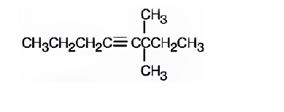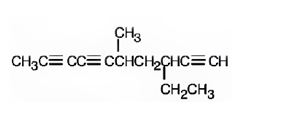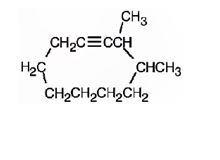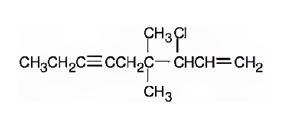
Concept explainers
Draw structures corresponding to the following names:
(a) 3, 3-Dimethyl-4-octyne
(b) 3-Ethyl-5-methyl-1, 6, 8-decatriyne
(c) 2, 2, 5, 5-Tetramethyl-3-hexyne
(d) 3, 4-Dimethylcyclodecyne
(e) 3, 5-Heptadien-1-yne
(f) 3-Chloro-4, 4-dimethyl-1-nonen-6-yne
(g) 3-sec-Butyl-1-heptyne
(h) 5-tert-Buty1-2-methyl-3-octyne
a) 3,3-Dimethyl-4-octyne.
Interpretation:
The structure of 3,3-Dimethyl-4-octyne is to be drawn.
Concept introduction:
The longest carbon chain containing the triple bond to be chosen. Based on the name of the parent compound–the alkyne name ends with the suffix–yne. The chain is to be numbered from the end that gives the lowest number to the carbon in triple bond. Substituents are to be numbered according to their positions in the chain and listed alphabetically. The position of the triple bond is indicated by giving the number of the first alkyne carbon before the name of the parent name. If more than one triple bond is present, their positions are indicated with the suffixes -diyne, -triyne and so on.
To draw:
The structure corresponding to the IUPAC name 3,3-dimethyl-4-octyne.
Answer to Problem 27AP
The structure corresponding to the IUPAC name 3,3-dimethyl-4-octyne is

Explanation of Solution
The name shows that the longest carbon chain should contain eight carbons with a triple bond between C4 & C5 and two methyl groups should be present on C3.
The structure corresponding to the IUPAC name 3,3-dimethyl-4-octyne is

b) 3-Ethyl-5-methyl-1,6,8-decatriyne.
Interpretation:
The structure of 3-ethyl-5-methyl-1,6,8-decatriyne is to be drawn.
Concept introduction:
The longest carbon chain containing the triple bond to be chosen. Based on the name of the parent compound–the alkyne name ends with the suffix–yne. The chain is to be numbered from the end that gives the lowest number to the carbon in triple bond. Substituents are to be numbered according to their positions in the chain and listed alphabetically. The position of the triple bond is indicated by giving the number of the first alkyne carbon before the name of the parent name. If more than one triple bond is present, their positions are indicated with the suffixes -diyne, -triyne and so on.
To draw:
The structure corresponding to the IUPAC name 3-ethyl-5-methyl-1,6,8-decatriyne.
Answer to Problem 27AP
The structure corresponding to the IUPAC name 3-ethyl-5-methyl-1,6,8-decatriyne is

Explanation of Solution
The name shows that the longest carbon chain should contain ten carbons with three triple bonds, one between C1 & C2, another between C6 & C7 a third one between C8 & C9, an ethyl group on C3 and a methyl group on C5.
The structure corresponding to the IUPAC name 3-ethyl-5-methyl-1,6,8-decatriyne is

c) 2,2,5,5- tetramethyl-3-hexyne.
Interpretation:
The structure of 2,2,5,5- tetramethyl-3-hexyne is to be drawn.
Concept introduction:
The longest carbon chain containing the triple bond to be chosen. Based on the name of the parent compound–the alkyne name ends with the suffix–yne. The chain is to be numbered from the end that gives the lowest number to the carbon in triple bond. Substituents are to be numbered according to their positions in the chain and listed alphabetically. The position of the triple bond is indicated by giving the number of the first alkyne carbon before the name of the parent name. If more than one triple bond is present, their positions are indicated with the suffixes -diyne, -triyne and so on.
To draw:
The structure corresponding to the IUPAC name 2,2,5,5- tetramethyl-3-hexyne.
Answer to Problem 27AP
The structure corresponding to the IUPAC name 2,2,5,5- tetramethyl-3-hexyne is

Explanation of Solution
The name shows that the longest carbon chain should contain six carbons with a triple bond between C3 & C4 and four methyl groups, two on C2 and another two on C5.
The structure corresponding to the IUPAC name 2,2,5,5- tetramethyl-3-hexyne is

d) 3,4-Dimethylcyclodeceyne.
Interpretation:
The structure of 3,4-Dimethylcyclodeceyne is to be drawn.
Concept introduction:
The longest carbon chain containing the triple bond to be chosen. Based on the name of the parent compound–the alkyne name ends with the suffix–yne. The chain is to be numbered from the end that gives the lowest number to the carbon in triple bond. Substituents are to be numbered according to their positions in the chain and listed alphabetically. The position of the triple bond is indicated by giving the number of the first alkyne carbon before the name of the parent name. If more than one triple bond is present, their positions are indicated with the suffixes -diyne, -triyne and so on.
To draw:
The structure corresponding to the IUPAC name 3,4-dimethyl cyclodeceyne.
Answer to Problem 27AP
The structure corresponding to the IUPAC name 3,4-dimethyl cyclodeceyne is

Explanation of Solution
The name shows that the compound contains a ring made up of ten carbon atoms with a triple bond attached to two methyl groups on C3 and C4.
The structure corresponding to the IUPAC name 3,4-dimethyl cyclodeceyne is

e) 3,5-Heptadiene-1-yne.
Interpretation:
The structure of 3,5-heptadiene-1-yne is to be drawn.
Concept introduction:
The longest carbon chain which contains the carbon-carbon triple bond is chosen. The chain is numbered from the end that gives the lowest number to the carbon in triple bond. Compounds with more than one triple bond are called diynes, triynes and so forth. Compounds containing both double bond and triple bonds are called as enynes. The chain is numbered from the end nearer to the multiple bonds, double or triple. When there is a choice in numbering the double bond is given preference and the lowest number is assigned to it.
To draw:
The structure corresponding to the IUPAC name 3,5-heptadiene-1-yne.
Answer to Problem 27AP
The structure corresponding to the IUPAC name 3,5-heptadiene-1-yne is

Explanation of Solution
The name shows that the longest carbon chain should contain seven carbons with a triple bond between C1 & C2 and two double bonds, one between C3 & C4 and another between C5 & C6.
The structure corresponding to the IUPAC name 3,5-heptadiene-1-yne is

f) 3-Chloro-4,4-dimethyl-1-nonene-6-yne.
Interpretation:
The structure of 3-chloro-4,4-dimethyl-1-nonene-6-yne is to be drawn.
Concept introduction:
The longest carbon chain which contains the carbon-carbon triple bond is chosen. The chain is numbered from the end that gives the lowest number to the carbon in triple bond. Compounds with more than one triple bond are called diynes, triynes and so forth. Compounds containing both double bond and triple bonds are called as enynes. The chain is numbered from the end nearer to the multiple bonds, double or triple. When there is a choice in numbering the double bond is given preference and the lowest number is assigned to it.
To draw:
The structure corresponding to the IUPAC name 3-chloro-4,4-dimethyl-1-nonene-6-yne.
Answer to Problem 27AP
The structure corresponding to the IUPAC name 3-chloro-4,4-dimethyl-1-nonene-6-yne is

Explanation of Solution
The name shows that the longest carbon chain should contain nine carbons with a triple bond between C6 & C7, one double bond between C1 & C2, a chlorine atom on C3 and two methyl groups on C4.
The structure corresponding to the IUPAC name 3-chloro-4,4-dimethyl-1-nonene-6-yne is

g) 3-sec-Butyl-1-heptyne.
Interpretation:
The structure of 3-sec-Butyl-1-heptyne is to be drawn.
Concept introduction:
The longest carbon chain containing the triple bond to be chosen. Based on the name of the parent compound–the alkyne name ends with the suffix–yne. The chain is to be numbered from the end that gives the lowest number to the carbon in triple bond. Substituents are to be numbered according to their positions in the chain and listed alphabetically. The position of the triple bond is indicated by giving the number of the first alkyne carbon before the name of the parent name. If more than one triple bond is present, their positions are indicated with the suffixes -diyne, -triyne and so on.
To draw:
The structure corresponding to the IUPAC name 3-sec-butyl-1-heptyne.
Answer to Problem 27AP
The structure corresponding to the IUPAC name 3-sec-butyl-1-heptyne is

Explanation of Solution
The name shows that the longest carbon chain should contain seven carbons with a triple bond between C1 & C2 and a sec-butyl group on C3.
The structure corresponding to the IUPAC name 3-sec-butyl-1-heptyne is

h) 5-tert-Butyl-2-methyl-3-octyne.
Interpretation:The structure of 5-tert-Butyl-2-methyl-3-octyne is to be drawn.
Concept introduction:
The longest carbon chain containing the triple bond to be chosen. Based on the name of the parent compound–the alkyne name ends with the suffix–yne. The chain is to be numbered from the end that gives the lowest number to the carbon in triple bond. Substituents are to be numbered according to their positions in the chain and listed alphabetically. The position of the triple bond is indicated by giving the number of the first alkyne carbon before the name of the parent name. If more than one triple bond is present, their positions are indicated with the suffixes -diyne, -triyne and so on.
To draw:
The structure corresponding to the IUPAC name 5-tert-Butyl-2-methyl-3-octyne.
Answer to Problem 27AP
The structure corresponding to the IUPAC name 5-tert-Butyl-2-methyl-3-octyne is

Explanation of Solution
The name shows that the longest carbon chain should contain eight carbons with a triple bond between C3 & C4, a tert-butyl group on C5 and a methyl group on C2.
The structure corresponding to the IUPAC name 5-tert-Butyl-2-methyl-3-octyne is

Want to see more full solutions like this?
Chapter 9 Solutions
EBK ORGANIC CHEMISTRY
- Denote the dipole for the indicated bonds in the following molecules. H3C ✓ CH3 B F-CCl 3 Br-Cl H3C Si(CH3)3 wwwwwww OH НО. HO HO OH vitamin C CH3arrow_forwardFor the SN2 reaction, draw the major organic product and select the correct (R) or (S) designation around the stereocenter carbon in the organic substrate and organic product. Include wedge-and-dash bonds and draw hydrogen on a stereocenter. Η 1 D EN Select Draw Templates More C H D N Erasearrow_forwardQ9: Explain why compound I is protonated on O while compound II is protonated on N. NH2 NH2 I IIarrow_forward
- AN IR spectrum, a 13 CMR spectrum, and a 1 HMR spectrum were obtained for an unknown structure with a molecular formula of C9H10. Draw the structure of this compound.arrow_forwardAN IR spectrum, a 13 CMR spectrum, and a 1 HMR spectrum were obtained for an unknown structure with a molecular formula of C9H10. Draw the structure of this compound.arrow_forward(a) What is the hybridization of the carbon in the methyl cation (CH3*) and in the methyl anion (CH3¯)? (b) What is the approximate H-C-H bond angle in the methyl cation and in the methyl anion?arrow_forward
- Q8: Draw the resonance structures for the following molecule. Show the curved arrows (how you derive each resonance structure). Circle the major resonance contributor.arrow_forwardQ4: Draw the Lewis structures for the cyanate ion (OCN) and the fulminate ion (CNO). Draw all possible resonance structures for each. Determine which form for each is the major resonance contributor.arrow_forwardIn the following molecule, indicate the hybridization and shape of the indicated atoms. CH3 N CH3 HÖ: H3C CI: ::arrow_forward
- Q3: Draw the Lewis structures for nitromethane (CH3NO2) and methyl nitrite (CH3ONO). Draw at least two resonance forms for each. Determine which form for each is the major resonance contributor.arrow_forwardQ1: Draw a valid Lewis structures for the following molecules. Include appropriate charges and lone pair electrons. If there is more than one Lewis structure available, draw the best structure. NH3 Sulfate Boron tetrahydride. C3H8 (linear isomer) OCN NO3 CH3CN SO2Cl2 CH3OH2*arrow_forwardQ2: Draw all applicable resonance forms for the acetate ion CH3COO. Clearly show all lone pairs, charges, and arrow formalism.arrow_forward
 ChemistryChemistryISBN:9781305957404Author:Steven S. Zumdahl, Susan A. Zumdahl, Donald J. DeCostePublisher:Cengage Learning
ChemistryChemistryISBN:9781305957404Author:Steven S. Zumdahl, Susan A. Zumdahl, Donald J. DeCostePublisher:Cengage Learning ChemistryChemistryISBN:9781259911156Author:Raymond Chang Dr., Jason Overby ProfessorPublisher:McGraw-Hill Education
ChemistryChemistryISBN:9781259911156Author:Raymond Chang Dr., Jason Overby ProfessorPublisher:McGraw-Hill Education Principles of Instrumental AnalysisChemistryISBN:9781305577213Author:Douglas A. Skoog, F. James Holler, Stanley R. CrouchPublisher:Cengage Learning
Principles of Instrumental AnalysisChemistryISBN:9781305577213Author:Douglas A. Skoog, F. James Holler, Stanley R. CrouchPublisher:Cengage Learning Organic ChemistryChemistryISBN:9780078021558Author:Janice Gorzynski Smith Dr.Publisher:McGraw-Hill Education
Organic ChemistryChemistryISBN:9780078021558Author:Janice Gorzynski Smith Dr.Publisher:McGraw-Hill Education Chemistry: Principles and ReactionsChemistryISBN:9781305079373Author:William L. Masterton, Cecile N. HurleyPublisher:Cengage Learning
Chemistry: Principles and ReactionsChemistryISBN:9781305079373Author:William L. Masterton, Cecile N. HurleyPublisher:Cengage Learning Elementary Principles of Chemical Processes, Bind...ChemistryISBN:9781118431221Author:Richard M. Felder, Ronald W. Rousseau, Lisa G. BullardPublisher:WILEY
Elementary Principles of Chemical Processes, Bind...ChemistryISBN:9781118431221Author:Richard M. Felder, Ronald W. Rousseau, Lisa G. BullardPublisher:WILEY





